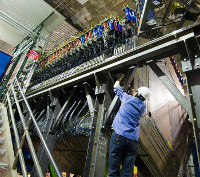Particle physics data in your classroom?

Neutrinos in the Classroom |
Particle physics data in your classroom? |
 |
|||
| Resources for Your Classroom | ||||
 |
This material is based upon work supported by the National Science Foundation under Grant No. 0619727 to the University of Rochester with a subaward to the University of Minnesota, Duluth. |
 |
 |